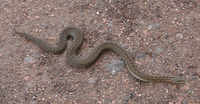

When people think of the dangers of animals bites they tend to think of someone being bitten by a poisonous animal normally a snake but all animal bites can be dangerous. Even if a bite contains no venom or venom not dangerous to humans in a survival situation there is a high risk of the bite becoming infected due to bacteria on the animal’s teeth, the most extreme example being that of the Komodo dragon who bite as well as being extremely powerful carried a lethal cocktail of bacteria which frequently causes the death of the victim. In many areas of the world many canines and other mammals may carry the rabies virus, a vaccination does exist but it can be painful to receive and the protection it offers is far from 100%.
Animal toxins are some of the most dangerous chemical compounds known to man and vary enormously in effect, from being as painful and as relatively harmless as a bee sting to having a high chance of killing or paralysing the victim. An individual’s reaction to a toxin can also vary greatly depending on size, age and general health of the victim. For example the UK has only one indigenous poisonous snake, the adder, the  bite from which is very painful but not normally dangerous, yet the same bite delivered to a child or an adult with a heart condition becomes potentially fatal. Very few poisonous animals intend to bite a human unless cornered , disturbed or threatened, if you encounter a snake , scorpion or other such animal , give it space and back away slowly in a quiet manner. When swimming a snorkel will help your vision and light sandals will protect your feet from poisonous animals you may step on, hidden in the sand or muck. The vast majority of poisonous animals are found in hotter climates with Australia having more poisonous species than any other continent. Out of the water, spiders, snakes, scorpions are the biggest risk, although some poisonous mammals and lizards do exist. The problem tends to be not from the larger species but the smaller ones, the bigger the creature generally (but not always) the weaker the venom is, for example the deadly and infamous Black Widow spider is tiny compared to large and relatively harmless bird eating spiders. Also small creatures can be easily over looked, trod on or even crawl into shoes when you are sleeping. General rules are wear good strong foot wear, check foot wear and bedding before putting on or getting into and don’t leave backpacks unattended on the ground in areas of risk. Finally when lifting rocks and bushes etc wear strong gloves or better still use a stick to probe the area.
bite from which is very painful but not normally dangerous, yet the same bite delivered to a child or an adult with a heart condition becomes potentially fatal. Very few poisonous animals intend to bite a human unless cornered , disturbed or threatened, if you encounter a snake , scorpion or other such animal , give it space and back away slowly in a quiet manner. When swimming a snorkel will help your vision and light sandals will protect your feet from poisonous animals you may step on, hidden in the sand or muck. The vast majority of poisonous animals are found in hotter climates with Australia having more poisonous species than any other continent. Out of the water, spiders, snakes, scorpions are the biggest risk, although some poisonous mammals and lizards do exist. The problem tends to be not from the larger species but the smaller ones, the bigger the creature generally (but not always) the weaker the venom is, for example the deadly and infamous Black Widow spider is tiny compared to large and relatively harmless bird eating spiders. Also small creatures can be easily over looked, trod on or even crawl into shoes when you are sleeping. General rules are wear good strong foot wear, check foot wear and bedding before putting on or getting into and don’t leave backpacks unattended on the ground in areas of risk. Finally when lifting rocks and bushes etc wear strong gloves or better still use a stick to probe the area.